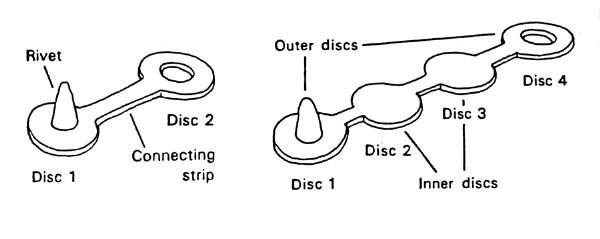Embodied in these small slivers of lead is so much
of England's past and Thames history. Cloth represented 90% of England's
exports in the 16th Century and was the main export until the industrial revolution.
London controlled 75-80% of this export trade, the Thames its conduit.
Cloth made up a large proportion of London’s
£1 million export trade in 1560. It must have been linked with the livelihoods of
many, many Londoners and funded so much of London's landscape.
Cloth seals were used across Europe from the late
14th century – the early 19th century as a means of
identification, quality control and were part of state administration. The
seals were attached to cloth by weavers, dyers or ‘alnagers’, crown officials who
assessed whether the goods were of requisite quality and that tax had
been paid.
Blank cloth seals were caste in stone moulds
| Stone Cloth Seal Mould (Bagseals.org) |
Cloth seals were usually two discs (occasionally four) joined by a thin
strip. One disc had a rivet, the other a hole. The discs were folded together over the edge of
the cloth, and hammered together with a die, which imprinted information onto
the lead disc.
It’s the intricate designs on so many of the cloth
seals which make them appealing. These can include the date and region of
production or inspection, touchingly personal maker’s marks or symbols
indicating alnage. The latter included heads of royalty, the crown, coats of
arms, griffins or lions rampart. Alnage was abandoned in 1724 and sealing was
abolished in 1889.
I haven’t found many cloth seals so far, but I’m now
on a bit of a mission. I’ve found one I suspect is an alnager’s with a very
small and faint crown at the top and either a letter or number below
Other examples of alnager’s cloth seals, all of
which will be 300+ years old, can be
found below
| Elizabeth I Alnage Cloth Seal 1558 onwards (bagseal gallery) |
| George I Alnage Cloth Seal 1714 onwards (bagseal gallery) |
| 17th C Alnage cloth Seal (http://proteus.brown.edu) |
The other one I’ve found I recon has a makers mark
on it
I found a few other pictures of seals with makers
marks.
| Cloth Workers Personal Cloth Seal 18th or 19th C (Bagseal Gallery) |
| Cloth Workers Personal cloth seal 1775-1825 (Bagseal Gallery) |
Sometimes you can see the texture of the cloth on the reverse, as in this case
Most of the cloth seals found in the UK come from
the Thames foreshore, most commonly from the late 15th to early 19th
centuries. One theory is that many
dropped off textiles during the finishing processes of shearing, dyeing and
fulling carried out in the many riverside workshops along the Thames. There was
a concentration of dye houses along Thames Street, between Cannon Street and
Southwark Bridge. In one study of seals found along the Thames, they identified
seals from 24 different counties together with imported seals and many from
London dyers.
The beauty of these Thames finds is that the tiny detailed
imprints are often perfectly preserved due to the Thames anaerobic mud, whereas
the lead found buried in other locations is often so badly corroded that no
surface detail remains.
There are a few sites which are helpful in
identifying cloth seals, including one put together by Stuart who generously
offers to identify your finds, here. Also LM has found loads of cloth seals on the Thames and her potted history is also worth a read here.
It’s taken me a couple of years of mudlarking and
the help of mudlarking friends to start spotting lead cloth seals along the
Thames foreshore. The trick is to go slowly and scan between the stones and
other debris, ‘look through them’ as one friend advised. Once you set your
heart on finding a particular type of find, you usually start spotting them and
don’t forget to take them down to the finds officer at the Museum of London.





i will keep my eyes open for them. will be on the foreshore on Sunday and Tuesday. Tides aren't great, but maybe my luck will be!!
ReplyDeleteThanks for the plug Julia. I just need a close up of both sides - http://www.bagseals.org/gallery/main.php?g2_itemId=1952
ReplyDeleteThis is what a cloth seal looks like with a weave imprint on it :- http://www.bagseals.org/gallery/main.php?g2_itemId=2394 this one is unusual in showing the imprint on the outside of the seal - from being pressed in an additional finishing process after it had been sealed. Stuart